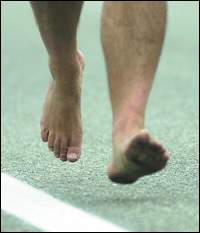Tips on Transitioning to Forefoot or Midfoot Striking

Forefoot striking barefoot or in minimal footwear requires you to
use muscles in your feet (mostly in the arch) that are probably very weak. Running this way also requires much
more strength in your calf muscles than heel striking because these muscles must contract eccentrically (while lengthening) to ease the heel onto the ground following the landing. Novice forefoot and midfoot strikers typically experience tired feet, and very stiff, sore calf muscles. In addition, the Achilles tendon often gets very stiff. This is normal and eventually goes away, but you can do several things to make the transition successfully:
- Build up slowly! If you vigorously work out any weak muscles in your body, they will be sore and stiff. Your foot and calf muscles will be no exception. So please, don’t overdo it because you will probably injure yourself if you do too much too soon.

- Start by walking around barefoot frequently.
- First week: no more than a quarter mile to one mile every other day.
- Increase your distance by no more than 10% per week. This is not a hard and fast rule, but a general guide. If your muscles remain sore, do not increase your training. Take an extra day off or maintain your distance for another week.
- Stop and let your body heal if you experience pain. Sore, tired muscles are normal, but bone, joint, or soft-tissue pain is a signal of injury.
- Be patient and build gradually. It takes months to make the transition.
- If you are currently running a lot, you don’t need to drastically reduce your mileage. Instead, supplement forefoot or midfoot striking with running the way that you normally ran before beginning the transition. Over the course of several months, gradually increase the proportion of forefoot or midfoot striking and reduce the proportion of running in your old style. Use the same 10% per week guideline in increasing the amount of running you do forefoot striking.
- It is essential to stretch your calves and hamstrings carefully and regularly as you make the transition. Massage your calf muscles and arches frequently to break down scar tissue. This will help your muscles to heal and get stronger.
- Listen to your feet. Stop if your arches are hurting, if the top of your foot is hurting, or if anything else hurts! Sometimes arch and foot pain occurs from landing with your feet too far forward relative to your hips and having to point your toes too much. It can also occur from landing with too rigid a foot and not letting your heel drop gently.
- Many people who run very slowly find that forefoot striking actually makes them run a little faster.
Listen to your body and have a good Run!
 Forefoot striking barefoot or in minimal footwear requires you to use muscles in your feet (mostly in the arch) that are probably very weak. Running this way also requires much more strength in your calf muscles than heel striking because these muscles must contract eccentrically (while lengthening) to ease the heel onto the ground following the landing. Novice forefoot and midfoot strikers typically experience tired feet, and very stiff, sore calf muscles. In addition, the Achilles tendon often gets very stiff. This is normal and eventually goes away, but you can do several things to make the transition successfully:
Forefoot striking barefoot or in minimal footwear requires you to use muscles in your feet (mostly in the arch) that are probably very weak. Running this way also requires much more strength in your calf muscles than heel striking because these muscles must contract eccentrically (while lengthening) to ease the heel onto the ground following the landing. Novice forefoot and midfoot strikers typically experience tired feet, and very stiff, sore calf muscles. In addition, the Achilles tendon often gets very stiff. This is normal and eventually goes away, but you can do several things to make the transition successfully:
No comments:
Post a Comment